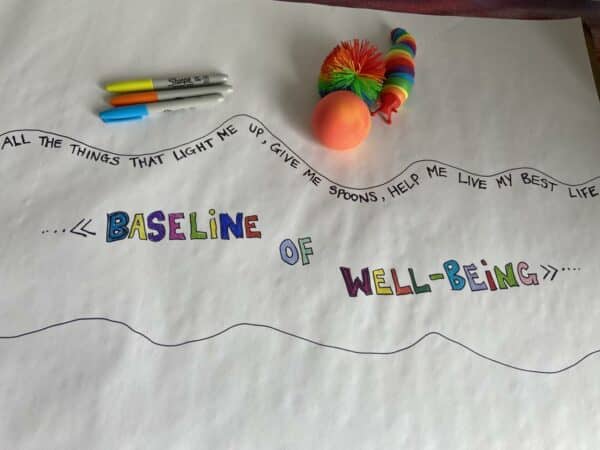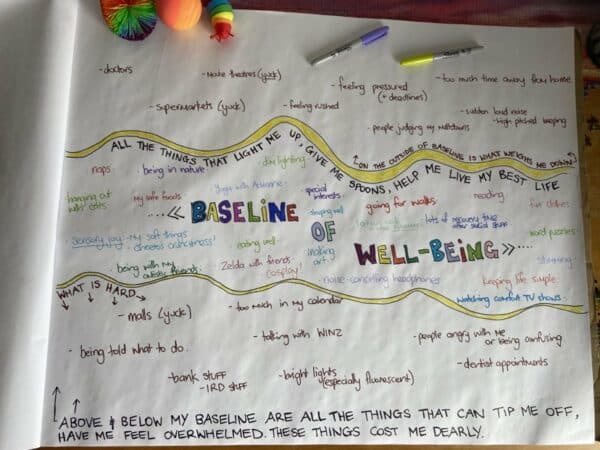
Anxiety wasn’t something I thought I had. Not until my later in life double diagnosis of autism and ADHD. I had thought everyone woke in utter dread and rolled with waves of jittery yuck. Spending time in Autistic communities it was clear that I was not alone. Anxiety is a hot topic in any Autistic space.
Designing a life that works for our Autistic selves is not a choice, it’s necessary. It’s our right to spend our days in a way that doesn’t tip us into burnout on repeat or into mental health trouble.
Sadly, because the source and our embodied experience of anxiety is different, and so many mental health, medical and care professionals are not neurodivergent-informed or affirming, the usual therapies and tools aren’t likely to work. Traditionally, the markers of success for treatment for extreme anxiety and / or chronic depression are the resuming of what I call ‘the gold standard neurotypical life’. You know, the 9-5 job or full-time attendance at school, active social life, hobbies, sports and ticking all the “appropriate behaviour” boxes sort of success. Problem is, even at our baseline best, that life is not possible for many of us neurodivergent folks to either attain or sustain. Nor should that sort of life be assumed as standard. Shoring up a life that doesn’t work for us turns into an unending loop of anxiety and burnout. We need to reframe success, each of us will have a unique definition of what that looks like.
To manage anxiety, we need to build a life on our strengths and prioritise what gives us energy rather than draining us. Wellbeing will look different for each of us but getting good sleep, eating and moving our bodies gives us a good foundation to create a sustainable life. Auditing our sensory diets, allowing ourselves the freedom to stim and buffering sensory-sourced anxiety with external supports like noise-cancelling headphones can all make a big difference to quality of life but without customising the structure of our lives to suit our unique needs, we have the potential risk of debilitating anxiety and burnout.
The foundational elements of health are not enough to avoid burnout
Even outside of burnout, a sizable chunk of the neurodivergent population works very hard to manage their anxiety and / or depression. There is a glaring need for more accessible support for Autistic folks to manage anxiety and other mental health issues, and more support people and professionals skilled in guiding us to learn how to structure life that works for each of our baseline capacities, sensory profiles and abilities.
An increase in anxiety levels, or a shift in a person’s experience of their anxiety, can flag that something needs to change in the person’s life, whether that be in how daily life is structured, the people we have around us, medication/s or the environments we move in. Everyone is different, there’s no standard formula for a rockin’ Autistic life BUT I’ve distilled a version of the life mapping process I developed in my neurodivergent specialist coaching practice into seven steps to custom design a sustainable life. This can be done solo, with some Autistic friends or a parent or support worker, perhaps a neuro-affirming and informed coach or therapist. Set aside a whole day and make an occasion of it with snacks or set aside time once a week to do it in chunks so there is time to process. Support team folks can customise the Life Mapping process to suit their people.
In my practice, before we get into the big picture work of life mapping, we explore what kind of life the person needs – what their unique Baseline of Wellbeing looks like.
Baseline of Wellbeing
What IS a Baseline of Wellbeing? A baseline is you at your best. It’s your ideal state of being. Where you have the most energy, are more able to regulate emotional responses, access your creativity, connect with others in your own way and stand strong in who you are. This is where you are at peak capacity for work and social load.
It’s incredibly sad to me that so many Autistic folks haven’t had much lived experience of their personal peak wellbeing. If this is the case with you, imagine what your baseline best life might be with the help of those who know and love you. We learn by trial and error so with reflection you’ll work out what you need as you go.
In coaching sessions, I represent the baseline as a wide curvy line on a big piece of paper or whiteboard as a reminder that our capacities and requirements of wellbeing shift and change in response to factors like life events, stress and health.
How to identify your Baseline of Wellbeing
To identify your Baseline of Wellbeing think back to times in your life when life was good, your workload and responsibilities felt manageable and you had a spring in your step. This gives us clues to what life needs to look like. For example, remembering the huge relief I felt when an emergency required me to let go of all responsibilities to be fully present and the fact that I felt best when I lived off-grid and travelled almost constantly for many years showed me I needed a simple life. The absence of feeling overwhelmed in these times informed me that I do best, am more resilient and my struggles more manageable in a simple life, when I am able to tackle one thing at a time.
Drawing your Baseline of Wellbeing
Draw two big wavy lines through the centre of a big piece of paper or with a digital tool. Between your two lines write what supports our wellbeing and helps us to live closer to our baseline. These are the things that light us up, what bring us joy or a sense of contentment, safety or satisfaction.
Some examples of what helps clients stay at their Baseline of Wellbeing: Yoga, cuddling cats / dogs, keeping paid work to X hours a week, watching anime, having a recovery time after a busy afternoon / day, taking meds, gaming, wearing bright coloured clothes, Dungeons and Dragons, reading, crafting, smoothies, going for walks, hanging out in online Autistic communities, sitting in the sun, drinking tea, listening to podcasts / audiobooks, stimming, eating safe and sensory-happy foods.
What throws us off our baselines and hikes up our anxiety?
Each of us will have a list unique to us. Trying to maintain a life that isn’t designed for us is the main culprit but spend some time noting down some answers specific to you and your life. You can write these on the top and bottom of the piece of paper or board with your baseline.
Here are some common causes of disruption to wellbeing to many Autistics: time in sensory taxing environments, chronic financial stress, abuse, too much pressure, unrealistic expectations, not getting enough sleep or downtime, physical ill-health, parenting small child/ren without appropriate support, working hours that are not sustainable, menopause, having to suppress stims, the effects of trauma, housing insecurity and the usual life stressors like changes in relationship status, loss of a job and bereavement can be felt intensely. Working with health, care, medical and / or education professionals who don’t understand autism is another. It’s often a mix of changes and stressors.
Baselines in summary. Things that light us up or are soothing and bring joy have us living closer to our baselines, too much stress, unsupported challenges and work that weigh us down have us deviate. When we’re off our baselines, neurodivergent traits flare, previously manageable anxiety and OCD or tics can start to spiral and life can start to feel hard.
Once we’ve established what our Baselines of Wellbeing look like, the next phase is to map out everything in our lives to see if anything needs to change. I’ve distilled a Life Mapping process I use in my coaching practice for you here but the more numerically minded Excel-loving Autistics might want to google Maja Toudal’s energy accounting.
Life mapping to design a life that works for you.
When serious overwhelm sets in or I’m showing signs of Autistic burnout I get a big piece of paper, hustle up coloured pens, put some uplifting music on and get to work mapping all the elements in my life. This life mapping process provides an opportunity to reflect and get clear on where and who we’re giving our precious energy to so we can assess what needs to shift. The mapping helps us get clarity on why we might be so exhausted too.
STEP ONE. Mapping & reflecting. Get everything in your life on a big piece of paper. Or use a digital tool like Google Jamboard or Miro.
All your commitments, responsibilities and activities go on that big piece of paper or digital board. Grouping in categories of work / study, house, life admin, play, relationships / friends / family, animals and community service can be helpful. Everything goes on there, the bolder the better.
STEP TWO. Traffic lights. What lights you up? What’s dragging you down? Go through your map and mark each life element with a red, orange or green ‘traffic light’:
Red light = activity, event, relationship or commitment is super taxing / costs many spoons.
Orange light = sort of meh, or neutral. Not terribly taxing but doesn’t add spoons to our drawers.
Green light = lights up the person, gives us energy, replenishes our spoon supply. These are the definite keepers.
STEP THREE. Check for balance. Turn your attention to your red lights. Are there more red than your green lights? Or do you have mostly orange lights? Does the hard stuff outweigh the bright? Pay attention to how you feel looking over your Life Map.
Go back to your Baseline of Wellbeing. Recall what brings you joy or deep satisfaction and keeps you closer to Wellbeing. How much of that is on your life map? Do you need to add more of what lights you up in your life? Remember, when you’re playing the game of life on hard mode, small changes and joys make a very big difference.
STEP FOUR. Identifying what needs to change. Go through your Life Map and start with your red traffic lights, assess what stays, what goes and what needs to change or be better supported. Jot down notes on your map as you go. What can you ditch? What needs changing? How can you do more of what brings you joy?
Don’t forget to factor in preparation and recovery time before and after social events and work commitments. We also need space in our lives for unexpected things like illness, family emergencies, emotional upsets, support workers coming and going.
It can be helpful to have a trusted person’s feedback and perspective for these last few steps.
STEP FIVE. Actioning change. We’re not looking at sudden drastic changes. Transitions and change can be hard for many neurodivergent folks, put plans in place to bridge and scaffold the red lighted things that need to stay part of your life and times of change. Action big decisions gently, in stages, and with support when appropriate. What are the gentle actionable steps to making healthy changes that will have you living closer to your Baseline of Wellbeing?
Make notes about how you might implement plans to stop or carve back various activities, either now or when needed. The sensory load of environments is important to consider too. Does that social meet-up at the noisy cafe come at too great a cost or does the noise mean you can’t fully participate? Can we ask for a change of venue? Wear noise buffering ear plugs or just take a break for a while?
When we’re struggling or nearing burnout, even the good things like going to yoga, game nights with pals, volunteering, lunch with aunty or social events in general might be in the too-hard basket and we definitely don’t need the things that are painful or unhealthy for us. That’s okay. To avoid burnout, we need to put ourselves first. We can always reinstate different activities later. Maybe not the super taxing things though, those can get in the bin and stay there.
STEP SIX. Have an anxiety action plan in the wings. Heightened intensity of anxiety and feeling chronically overwhelmed can be red flags indicating a slide toward burnout. It’s helpful to know ahead of time what can be put on hold while you focus on getting back to your baseline. Have a look at your life map, what can be carved back if you need to? How would you do that? How can you integrate more of what brings you joy? What support can you identify to help you recover? It’s hard to think creatively when we’re struggling, having a plan ready to action has us feel prepared – it’s a safety net we’re gifting our future selves.
Give yourself the green light
A hot tip on integrating our Life Map learnings into daily life is to use traffic lights on your to-do lists, reminder apps and calendars. This allows us to see if we’re on track to create the days we need. In burnout you might have only green light items on your list some days.
What we find taxing or enriching will change through life delivering new ways burnout can sneak up on us, but knowing our Baseline of Wellbeing and having a built-in reflection time like Life Mapping can be an important tool to living your best neurodivergent life.
Trying to live a life designed for neurotypical people is a set up. Give yourself permission to live life on your terms.
We all deserve to live a life that works for our unique Autistic selves.
- Anissa Ljanta is an Advisor for Altogether Autism.
This article first appeared in the Altogether Autism Journal, Autism and Anxiety 2023.




